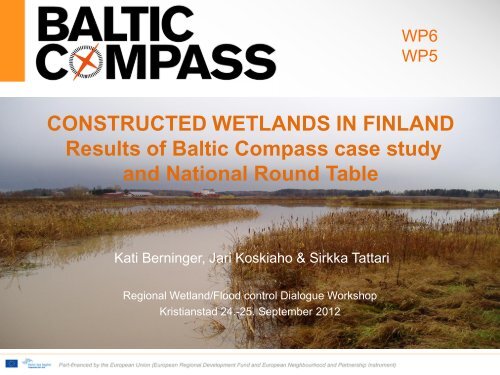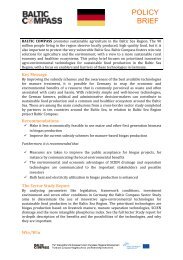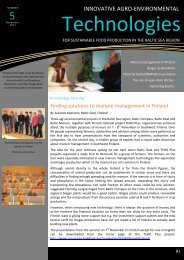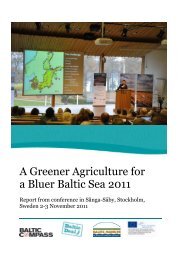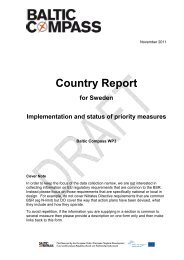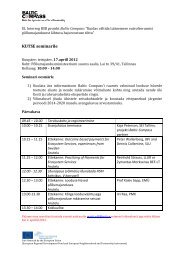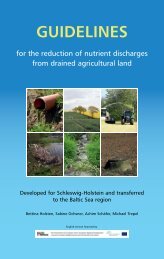Constructed wetlands in Finland - Berninger, Koskiaho and Tattari
Constructed wetlands in Finland - Berninger, Koskiaho and Tattari
Constructed wetlands in Finland - Berninger, Koskiaho and Tattari
Create successful ePaper yourself
Turn your PDF publications into a flip-book with our unique Google optimized e-Paper software.
WP6<br />
WP5<br />
CONSTRUCTED WETLANDS IN FINLAND<br />
Results of Baltic Compass case study<br />
<strong>and</strong> National Round Table<br />
Kati Bern<strong>in</strong>ger, Jari <strong>Koskiaho</strong> & Sirkka <strong>Tattari</strong><br />
Regional Wetl<strong>and</strong>/Flood control Dialogue Workshop<br />
Kristianstad 24.-25. September 2012
Baltic Compass work on<br />
<strong>wetl<strong>and</strong>s</strong> <strong>in</strong> F<strong>in</strong>l<strong>and</strong><br />
• Focus on constructed <strong>wetl<strong>and</strong>s</strong> <strong>in</strong> agricultural<br />
environments<br />
• Case study to<br />
– Describe the current knowledge on the function<strong>in</strong>g of <strong>wetl<strong>and</strong>s</strong><br />
largely based on automatic monitor<strong>in</strong>g data from exist<strong>in</strong>g<br />
<strong>wetl<strong>and</strong>s</strong><br />
– Describe the F<strong>in</strong>nish wetl<strong>and</strong> support system <strong>and</strong> its historical<br />
development<br />
– Analyze the enabl<strong>in</strong>g factors <strong>and</strong> barriers related to the current<br />
wetl<strong>and</strong> support<br />
– Give recommendations for the new programm<strong>in</strong>g period<br />
• National Round Table Workshop on April 18 th 2012<br />
discuss<strong>in</strong>g<br />
– new ways of promot<strong>in</strong>g the construction of <strong>wetl<strong>and</strong>s</strong><br />
– the potential of collective action<br />
• Wetl<strong>and</strong> excursion on September 6th 2012
Why construct <strong>wetl<strong>and</strong>s</strong>?<br />
• In F<strong>in</strong>l<strong>and</strong> many natural <strong>wetl<strong>and</strong>s</strong> have been dried<br />
dur<strong>in</strong>g the last few centuries<br />
– Compet<strong>in</strong>g l<strong>and</strong> uses do not allow the formation of new<br />
natural <strong>wetl<strong>and</strong>s</strong><br />
• <strong>Constructed</strong> <strong>wetl<strong>and</strong>s</strong> return<strong>in</strong>g some of the lost<br />
capacity to reta<strong>in</strong> floods, erosion <strong>and</strong> nutrients<br />
• Wetl<strong>and</strong>s are also important for their biodiversity,<br />
recreational <strong>and</strong> hunt<strong>in</strong>g values
F<strong>in</strong>nish <strong>wetl<strong>and</strong>s</strong><br />
• Most of the constructed<br />
<strong>wetl<strong>and</strong>s</strong> are small, about<br />
1 ha. A few large <strong>wetl<strong>and</strong>s</strong><br />
• Automatic water quality<br />
measurements of<br />
<strong>in</strong>flow<strong>in</strong>g <strong>and</strong> outflow<strong>in</strong>g<br />
water <strong>in</strong> some areas
The nutrient retention capacity of a<br />
wetl<strong>and</strong> is good when:<br />
The water stays a long time even dur<strong>in</strong>g<br />
flood<strong>in</strong>g periods<br />
The size of the wetl<strong>and</strong> compared to the<br />
catchment area above it – dimension<strong>in</strong>g<br />
High nutrient concentrations <strong>in</strong> the<br />
<strong>in</strong>com<strong>in</strong>g water<br />
Hydraulic efficiency – utiliz<strong>in</strong>g the whole<br />
wetl<strong>and</strong> area efficiently<br />
Remov<strong>in</strong>g top soil before construction–<br />
removes also dissolved phosphorus
Turbidity (FTU)<br />
10.10.07<br />
9.11.07<br />
10.12.07<br />
9.1.08<br />
9.2.08<br />
10.3.08<br />
10.4.08<br />
10.5.08<br />
10.6.08<br />
10.7.08<br />
10.8.08<br />
9.9.08<br />
10.10.08<br />
9.11.08<br />
10.12.08<br />
9.1.09<br />
9.2.09<br />
11.3.09<br />
11.4.09<br />
11.5.09<br />
11.6.09<br />
11.7.09<br />
11.8.09<br />
10.9.09<br />
11.10.09<br />
10.11.09<br />
11.12.09<br />
10.1.10<br />
5.5.10<br />
4.6.10<br />
5.7.10<br />
4.8.10<br />
4.9.10<br />
4.10.10<br />
4.11.10<br />
4.12.10<br />
Example of an “ideal” wetl<strong>and</strong><br />
4000<br />
Inflow<br />
3000<br />
Outflow<br />
2000<br />
1000<br />
0<br />
Time
Flow <strong>and</strong> retention <strong>in</strong> the Hovi wetl<strong>and</strong> based on<br />
sensor data <strong>in</strong> 2007–2011* <strong>and</strong> on water sampl<strong>in</strong>g <strong>in</strong><br />
1999–2000**<br />
Period<br />
Inflow<br />
(mm)<br />
TSS ret.<br />
(kg/ha)<br />
NO3 ret.<br />
(kg/ha)<br />
TP ret.<br />
(kg/ha)<br />
2007–2008 417 30 300 (70%) 133 (67%) 45 (67%)<br />
2008–2009 287 15 200 (57%) 38 (54%) 22 (53%)<br />
2009–2010 570 16 200 (71%) 251 (84%) 23 (71%)<br />
2010–2011 160 6 300 (92%) 67 (79%) 10 (91%)<br />
Mean 2007–2011 358 17 000 (68%) 122 (75%) 25 (66%)<br />
1999–2000 341 24 300 (68%) 220 (35%) 24 (62%)<br />
*Unpublished<br />
**<strong>Koskiaho</strong>, J., Ekholm, P., Räty, M., Riihimäki, J. & Puust<strong>in</strong>en, M. 2003.<br />
Reta<strong>in</strong><strong>in</strong>g agricultural nutrients <strong>in</strong> constructed <strong>wetl<strong>and</strong>s</strong> - experiences<br />
under boreal conditions. Ecological Eng<strong>in</strong>eer<strong>in</strong>g 20(1): 89-103.
F<strong>in</strong>nish wetl<strong>and</strong> support<br />
• The support is ma<strong>in</strong>ly based on water<br />
protection efficiency<br />
– Eligibility criteria:<br />
• Fields cover > 20 % of the catchment area<br />
• Size of wetl<strong>and</strong> ≥ 0.5 % of upstream catchment<br />
• At least 0.3 ha of size<br />
• Target: 1626 new <strong>wetl<strong>and</strong>s</strong> by nonproductive<br />
<strong>in</strong>vestment support<br />
– Positive decisions dur<strong>in</strong>g 2008-2011 165<br />
= 10 % of the target
The role of projects<br />
• Wetl<strong>and</strong> promotion, advise <strong>and</strong> wetl<strong>and</strong> plann<strong>in</strong>g<br />
– TEHO project<br />
– Järki project<br />
• Also fund<strong>in</strong>g <strong>and</strong> support dur<strong>in</strong>g the whole process<br />
– Return of Rural Wetl<strong>and</strong>s Life+ project<br />
– WWF wetl<strong>and</strong> project<br />
– Vesijärvi Foundation<br />
– Have built all together 59 <strong>wetl<strong>and</strong>s</strong><br />
• Made possible the construction of <strong>wetl<strong>and</strong>s</strong> not<br />
eligible for wetl<strong>and</strong> support<br />
• Drafted regional wetl<strong>and</strong> plans
Construct<strong>in</strong>g <strong>wetl<strong>and</strong>s</strong> <strong>in</strong> dra<strong>in</strong>age projects<br />
• A great potential for wetl<strong>and</strong> construction <strong>in</strong> connection<br />
with dra<strong>in</strong>age cooperation<br />
– Several l<strong>and</strong>owners <strong>in</strong>volved<br />
• Broaden<strong>in</strong>g th<strong>in</strong>k<strong>in</strong>g to cover all measures slow<strong>in</strong>g down<br />
the water flow<br />
– levell<strong>in</strong>g of ditch banks, construction of flood<strong>in</strong>g terraces or<br />
me<strong>and</strong>er<strong>in</strong>g<br />
• Good dra<strong>in</strong>age reduces nutrient leach<strong>in</strong>g from fields by<br />
<strong>in</strong>creas<strong>in</strong>g productivity<br />
• Dra<strong>in</strong>age projects<br />
with environmental<br />
measures as<br />
examples of w<strong>in</strong>w<strong>in</strong><br />
situations
Support<strong>in</strong>g <strong>wetl<strong>and</strong>s</strong> through l<strong>and</strong> consolidation<br />
• L<strong>and</strong> consolidation projects aim at gett<strong>in</strong>g larger parcels<br />
easier to cultivate<br />
– The state may offer alternative l<strong>and</strong> parcels<br />
• Projects may also take potential wetl<strong>and</strong> locations <strong>in</strong>to<br />
account<br />
• L<strong>and</strong> consolidation could solve several problems related to<br />
<strong>wetl<strong>and</strong>s</strong>:<br />
– l<strong>and</strong>owners not <strong>in</strong>terested <strong>in</strong> cooperation could get a l<strong>and</strong> parcel<br />
outside the wetl<strong>and</strong> area<br />
– wetl<strong>and</strong> areas could follow the l<strong>and</strong>owner’s borders<br />
– if the water covers productive fields, they could be compensated by<br />
an equal parcel elsewhere
Lessons learned I<br />
• Support should be organized so that farmers don’t have<br />
to take f<strong>in</strong>ancial or other risks dur<strong>in</strong>g the wetl<strong>and</strong> project<br />
• Wetl<strong>and</strong> support is needed for both water protection <strong>and</strong><br />
biodiversity reasons. The target areas may differ.<br />
• A special support for collaborative projects <strong>in</strong>volv<strong>in</strong>g<br />
several l<strong>and</strong>owners needed<br />
• Farmers need help dur<strong>in</strong>g the whole wetl<strong>and</strong><br />
construction process from plann<strong>in</strong>g to f<strong>in</strong>d<strong>in</strong>g <strong>and</strong><br />
supervis<strong>in</strong>g contractors.
Lessons learned II<br />
• The best results have been reached <strong>in</strong> wetl<strong>and</strong> projects<br />
managed by NGOs/special funds who work directly with<br />
farmers<br />
• Higher support level for watersheds/projects with a<br />
particularly good potential to reduce nutrient load<br />
– may be seen as a way to implement outcome-based support<br />
• We need to learn more about manag<strong>in</strong>g <strong>wetl<strong>and</strong>s</strong>
More <strong>in</strong>fo<br />
• Report of the Baltic Compass project:<br />
Bern<strong>in</strong>ger, K., <strong>Koskiaho</strong>, J. & <strong>Tattari</strong>, S. 2012. <strong>Constructed</strong> <strong>wetl<strong>and</strong>s</strong><br />
<strong>in</strong> F<strong>in</strong>nish agricultural environments: Balanc<strong>in</strong>g between effective<br />
water protection <strong>and</strong> multi-functionality. 29 p.<br />
Thank you!<br />
sirkka.tattari@ymparisto.fi, kati_bern<strong>in</strong>ger@yahoo.ca


